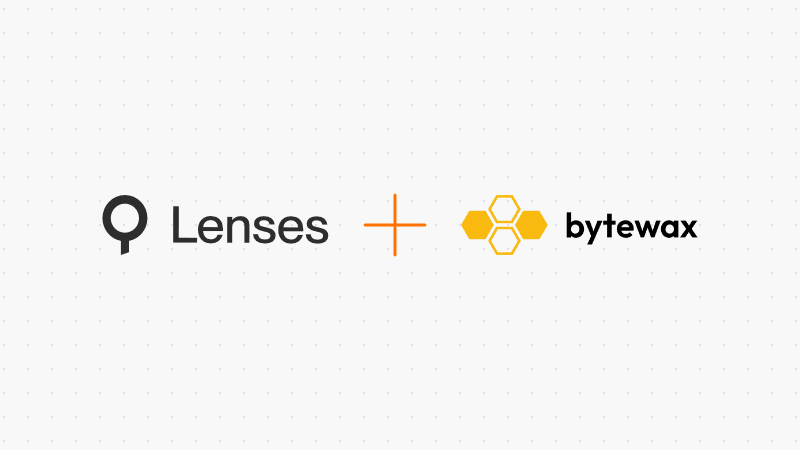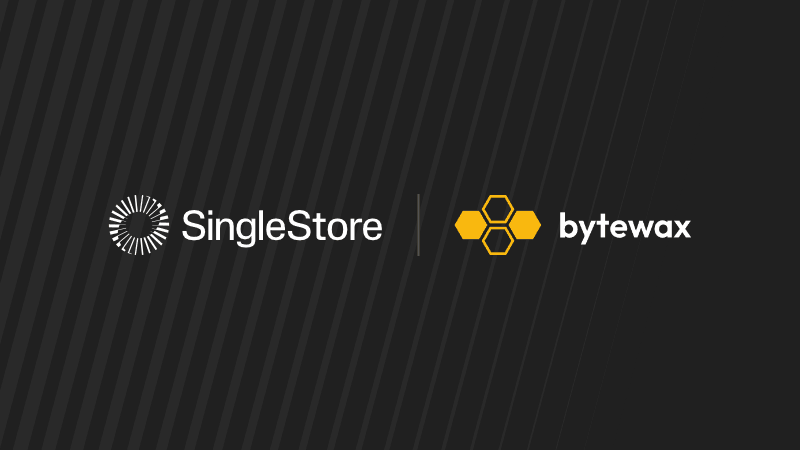
How Bytewax Beats Flink in Efficiency, Cost, and Ease of Use
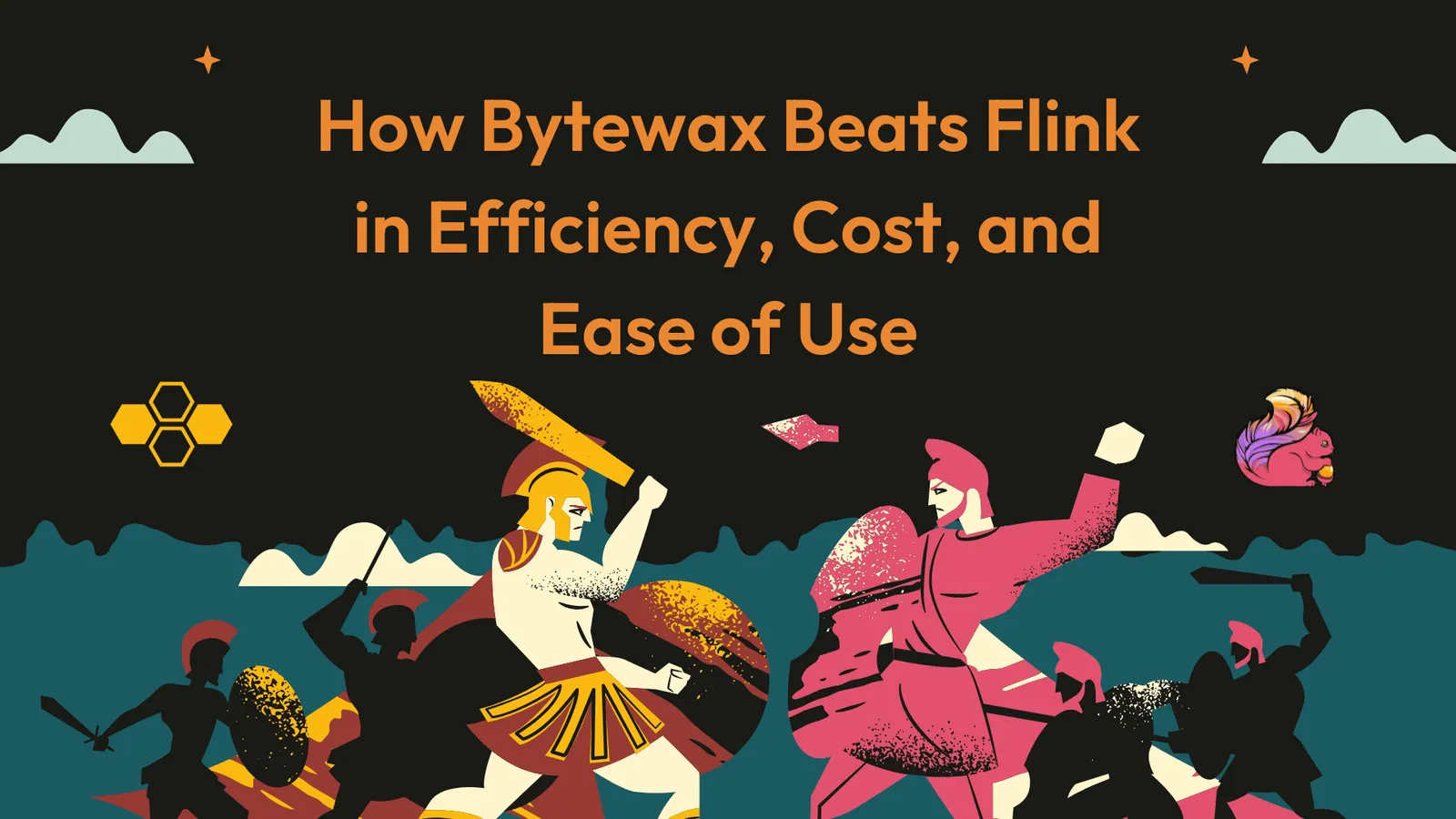
Introduction
Stream processing is essential to modern data infrastructure, enabling real-time insights and large-scale decision-making. Apache Flink and Bytewax are two leading stateful stream processing frameworks, each with unique strengths. Although Flink pioneered stateful streaming in the early 2010s and drove the first wave of real-time applications, its complexity and high cost have limited broader adoption.
True democratization of stream processing means making it accessible to more developers—not just specialized data engineers—and reducing total ownership costs. A study by McKnight Consulting Group found that Bytewax excels over Flink in ease of use, memory efficiency, and overall cost.
In this blog, we explore how Bytewax offers a more efficient, developer-friendly approach to stream processing, making it an ideal choice for organizations ready to embrace real-time data.
Barriers to Apache Flink’s Broader Adoption
Apache Flink has been successfully adopted by specialized data engineers in large-scale enterprises like Netflix and Uber. However, as a legacy Big Data era tool, it struggles to appeal to developers outside of data engineering and to companies with faster development cycles focused on AI and Machine Learning.
There is no doubt that Flink is a very performant and scalable stream processing solution that has earned its place as a leader in stateful streaming. However, Flink's wider adoption is limited by several challenges:
- Poor Python Experience
PyFlink lags behind the Java API with limited feature parity, frequent bugs, and cumbersome debugging. Its nature as a thin wrapper over Java leads to complex cross-language serialization and configuration challenges. - High Memory Consumption
Flink’s JVM-based architecture incurs significant memory overhead, often up to 3GB per workload—limiting its use in resource-constrained and edge deployments. - Steep Learning Curve
Despite the Python SDK, effective use of Flink still requires deep Java expertise for debugging, state management, and pipeline optimization, making the ramp-up process particularly challenging. - Long Development Time
Flink demands high development effort and cross-team collaboration between Data Engineers and Data Consumers, resulting in prolonged time-to-production. - High Infrastructure Costs
The memory-intensive operations and JVM overhead drive cloud compute expenses, increasing overall infrastructure costs.
How Bytewax Democratizes Stream Processing
Bytewax was built to make stream processing more accessible for a new generation of developers—ML/AI engineers, MLOps engineers, and data scientists—who are focused on real-time analytics, artificial intelligence, and machine learning solutions. It is a Python-native, lightweight, and scalable stream processing engine that simplifies the development and deployment of real-time pipelines.
- Python-Native & Developer-Friendly
Bytewax fully leverages the Python ecosystem of data science, AI, and machine learning libraries, allowing developers to perform advanced real-time data transformations without relying on external infrastructure dependencies such as the JVM. - Ease of Use & Faster Development
Bytewax streamlines the development process, enabling teams to build, test, and iterate on streaming pipelines more quickly and efficiently—helping to bring new solutions to market faster. - Resource Efficiency
With its low memory footprint, Bytewax maximizes resource utilization by allowing more pipelines to run on a single virtual machine or in resource-constrained edge environments. - Scalable, High-Performance Processing
Built with Rust at its core, Bytewax delivers robust, high-performance stream processing with efficient resource usage, ensuring smooth scalability across distributed environments. - Connectivity
Bytewax isn’t dependent on any single messaging system like Kafka. It offers a broad suite of out-of-the-box connectors to many popular data sources and sinks. Moreover, Bytewax makes it easy for developers to create custom connectors, ensuring seamless integration with a wide range of systems.
Benchmarking: Bytewax vs. Flink
How does Bytewax measure up against Flink for modern Python developers? McKnight's benchmarking report evaluates both solution on key metrics such as ease of use and total cost of ownership (TCO). The findings reveal several noteworthy insights that underscore Bytewax’s advantages in streamlining development and lowering operational expenses.
Ease of Use & Development Effort
McKnight built four typical stream processing pipelines on both Bytewax and Flink, measuring development effort in agile story points (with one story point corresponding to one working day for a single developer).
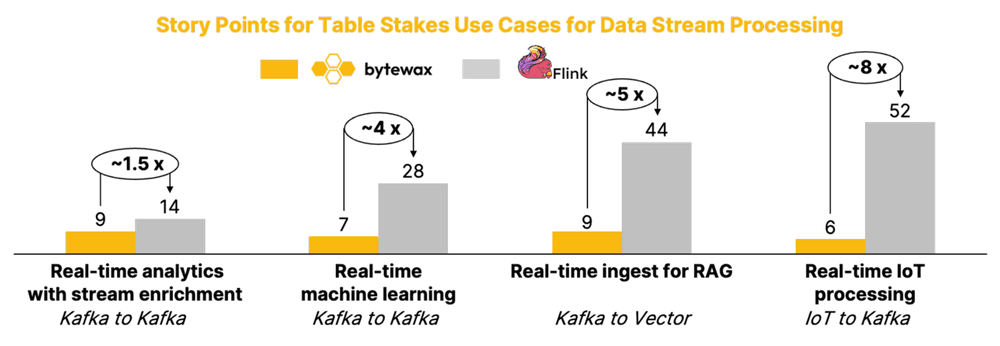
Bytewax demonstrates a clear edge, enabling up to 8× faster development. Its Python-native design simplifies tasks such as writing connectors and integrating AI libraries for data vectorization.
| Development & Maintenance | Bytewax | Flink |
|---|---|---|
| Development Story Points per Year | 124 | 552 |
| Maintenance Story Points per Year | 31 | 166 |
| Total CICD Points per Year | 155 | 718 |
Overall, Bytewax requires 1.5× to 8× less development effort than Flink. In practical terms, a task that might take a developer one month with Flink can be completed in under a week with Bytewax.
Infrastructure Usage & Cost
Infrastructure costs were estimated based on effective memory usage on a memory-optimized EC2 instance on AWS. McKnight’s findings for memory consumption are as follows:
| Memory Consumption | Bytewax | Flink |
|---|---|---|
| Per Pipeline | 0.4 GB | 9.6 GB |
| Total Memory Consumption | 4.1 GB | 97.9 GB |
Bytewax exhibits up to a 25× lower memory footprint than Flink. This resource efficiency not only allows for the deployment of more pipelines—even in resource-constrained environments such as edge deployments—but also significantly reduces cloud infrastructure costs.
| Cloud Infrastructure Costs (EC2) | Bytewax | Flink |
|---|---|---|
| Monthly | $758 | $3,130 |
| Yearly | $9,096 | $37,564 |
Overall, Bytewax incurs around 4× lower cloud infrastructure costs than Flink. (Note: Cloud cost savings do not scale linearly with memory usage, as factors like cluster availability also affect costs. See McKnight's report for details.)
Total Cost of Ownership
Total Cost of Ownership (TCO) is primarily determined by infrastructure expenses combined with the labor costs for development and maintenance. McKnight estimated the annual TCO for developing and maintaining four streaming pipelines as follows:
| Total Cost of Ownership | Bytewax | Flink |
|---|---|---|
| Annual People Cost for Development & Maintenance | $113,460 | $525,283 |
| Annual Infrastructure Costs | $9,096 | $37,562 |
| Total Cost of Ownership (Annualized) | $122,556 | $562,846 |
Bytewax achieves a 4.6× lower TCO than Flink. In this scenario, a company managing four streaming pipelines can save approximately $440,000 per year with Bytewax—and potentially much more at larger scales. More importantly, these savings are driven by reduced development effort, which translates into a much faster time to production.
In conclusion, Bytewax is not only more cost-effective but also accelerates time to production, enabling companies to develop, test, and deploy real-time pipelines more efficiently with their existing teams.
Why Stream Processing Needs to be Accessible and Affordable
For many companies and development teams, the barriers to adopting real-time processing remain high. Most organizations lack the resources to hire specialized engineers solely dedicated to managing Flink. Moreover, the high costs restrict stream processing to large-scale use cases—where even those deployments suffer from a high TCO that severely impacts ROI.
Making stream processing both accessible and affordable is transformative. It enables smaller and resource-constrained companies to tap into real-time data and, for larger organizations, makes it possible to build streaming pipelines that were once cost-prohibitive.
The TCO chart below clearly illustrates how Bytewax lowers the barrier to entry for stream processing:
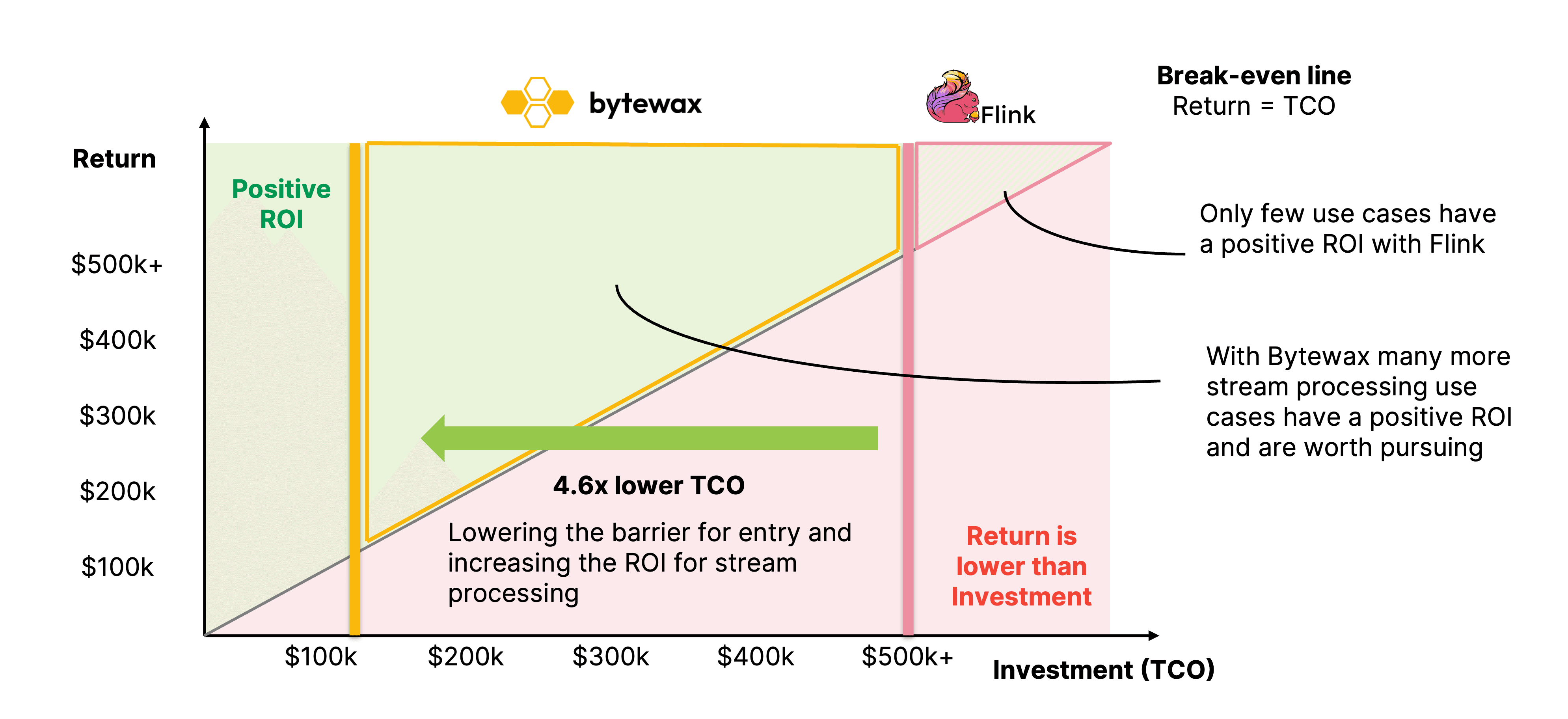
At Bytewax, we observe firsthand the transformative benefits of faster development and a better TCO, which benefit both large corporates and startups:
Large Corporates
One of the world’s leading social media networks—whose name cannot be disclosed—operates one of the largest Flink clusters in the world. Despite having the scale to achieve a positive ROI with Flink, they are increasingly turning to Bytewax for real-time machine learning use cases. Bytewax enables their ML/AI engineers to rapidly build and iterate new streaming pipelines, allowing them to bring new products to market faster and improve their streaming pipelines in an agile manner.
Startups
A prime example of Bytewax empowering startups is Range Energy. With a small engineering team and without a dedicated data engineer, they built and deployed several real-time pipelines to production in record time. Their use case—requiring a complex algorithm to match GPS route segments for their vehicles in real time—would have demanded expensive custom development with Flink. With Bytewax, they tapped into the vast Python ecosystem and seamlessly integrated a specialized Python library. Link to Case Study.
Conclusion
Many large corporates still rely on Flink for large-scale, mission-critical real-time workloads because of its proven performance and scalability. As a legacy tool with a long track record, Flink is seen as a high-cost, low-risk option for organizations that can absorb the expense. However, these high costs and steep learning curves restrict many use cases and prevent smaller companies or teams from effectively leveraging real-time data.
By lowering both the costs and entry barriers, more accessible and affordable stream processing democratizes real-time data use and makes a wider range of applications feasible. Bytewax is not only a lower-cost alternative to Flink—it also accelerates time to production. Many companies aiming to move faster with smaller teams of data scientists, ML/AI engineers, or MLOps professionals choose Bytewax because it allows them to develop and test streaming pipelines locally and use the same code to move to production.
Moreover, Bytewax’s Python-native design opens up new possibilities for ML/AI and data science by integrating seamlessly with the vast Python ecosystem and supporting advanced data transformations that go beyond the capabilities of SQL.
Get Started with Bytewax
Bytewax is designed to simplify stream processing for organizations of all sizes, making it easier and more cost-effective to build, test, and deploy real-time pipelines. Whether you’re considering a migration from Flink, looking to enhance your data infrastructure, or simply exploring modern stream processing techniques, we invite you to join our community. Connect with us on our Slack community and star us on GitHub.
Integrating Bytewax with SingleStore for a Kafka Sink

Anastasia Khomyakova

Jonas Best
Chief of StaffChanging Data and AI Roles Require new Tools
Other posts you may find interesting
View all articles
